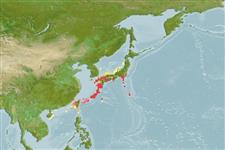Common names from other countries
Klassifizierung / Names
Namen | Synonyme | Catalog of Fishes(Gattung, Arten) | ITIS | CoL | WoRMS | Cloffa
>
Acropomatiformes (Oceanic basses) >
Pempheridae (Sweepers)
Etymology: Pempheris: Greek, pempheris = the name of a fish (Ref. 45335); ufuagari: Name from coming from the traditional Okinawan dialect meaning ''eastern end''. The type locality Minami Daito Island was called 'Ufuagari-jima' (jima means island) by the Okinawan people before 1885 when the Meiji government of Japan first landed.
Environment: milieu / climate zone / Tiefenbereich / distribution range
Ökologie
seewasser pelagic-neritic; tiefenbereich 2 - 5 m (Ref. 92923). Temperate
Northwest Pacific: Japan.
Size / Gewicht / Alter
Geschlechtsreife: Lm ? range ? - ? cm
Max length : 19.7 cm SL Männchen/unbestimmt; (Ref. 92923)
Kurzbeschreibung
Bestimmungsschlüssel | Morphologie | Morphometrie
Rückenflossenstacheln (insgesamt) : 6; Rückenflossenweichstrahlen (insgesamt) : 9; Afterflossenstacheln: 1; Afterflossenweichstrahlen: 39 - 43; Wirbelzahl: 25. This species is distinguished by the following characters: scale rows above lateral line 6 1/2-7 1/2 (usually 7 1/2); pored lateral-line scales 62-71; scales are weakly ctenoid, thin, semicircular in shape, far wider than long, and deciduous; convex snout outline in anterior part of orbit; tip of dorsal fin broadly black, the rest is bright yellow; base of anal fin blackish; distinct blackish band on outer margin; posterior margin of caudal fin blackish, the rest bright yellow; distinct blackish spot
on pectoral-fin base; absence of villiform tooth band extending outside lips on the upper and lower jaws (Ref. 92923).
Body shape (shape guide): short and / or deep; Cross section: compressed.
Apparently occurs in underwater caves or crevasses in coral reef areas during the day, but found in open water at night (Ref.92923).
Life cycle and mating behavior
Geschlechtsreife | Fortpflanzung | Ablaichen | Eier | Fecundity | Larven
Koeda, K., T. Yoshino and K. Tachihara, 2013. Pempheris ufuagari sp. nov., a new species in the genus Pempheris (Perciformes, Pempheridae) from the oceanic islands of Japan. Zootaxa 3609(2):231-238. (Ref. 92923)
IUCN Rote Liste Status (Ref. 130435: Version 2025-1)
Bedrohung für Menschen
Harmless
Nutzung durch Menschen
Tools
Zusatzinformationen
Download XML
Internet Quellen
Estimates based on models
Preferred temperature (Ref.
123201): 20.5 - 26.2, mean 23.5 °C (based on 113 cells).
Phylogenetic diversity index (Ref.
82804): PD
50 = 0.5000 [Uniqueness, from 0.5 = low to 2.0 = high].
Bayesian length-weight: a=0.01380 (0.00591 - 0.03225), b=3.02 (2.83 - 3.21), in cm total length, based on LWR estimates for this Genus-body shape (Ref.
93245).
Trophic level (Ref.
69278): 3.5 ±0.5 se; based on size and trophs of closest relatives
Widerstandsfähigkeit (Ref.
120179): mittel, Verdopplung der Population dauert 1,4 - 4,4 Jahre. (Preliminary K or Fecundity.).
Fishing Vulnerability (Ref.
59153): Low vulnerability (14 of 100).
🛈
